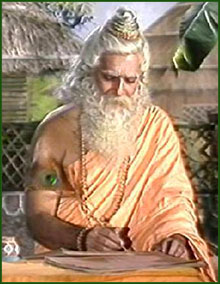 With this post we will begin adding Abbot George’s Commentary on Patanjali’s Yoga Sutras to our Blog’s rotation of articles. We hope you find it useful.
With this post we will begin adding Abbot George’s Commentary on Patanjali’s Yoga Sutras to our Blog’s rotation of articles. We hope you find it useful.
Introduction to the Yoga Sutras
The text known as the Yoga Sutras of Patanjali is a repository of transcendental knowledge. Poetic and exaggerated as that may sound, it is neither, but is simple fact, as anyone can learn for himself by practice of its instructions. The proof of the pudding is in the eating. It is also known as the Yoga Darshana because it is the fundamental text of Yoga not as a practice (though practice is discussed) but as a philosophy, as one of the six orthodox systems (darshanas) of Hindu religion: Sanatana Dharma.
The basis of Sanatana Dharma
There is a temptation to designate a single book as the greatest or most important book in the the world. The Yoga Darshana is one of these, but in reality it is one of fourteen texts upon which the totality of authentic Sanatana Dharma is based. When those texts are studied and applied, then a person is a Sanatana Dharmi–not a “member” or “adherent” of Sanatana Dharma, but an embodiment of Dharma, one who is moving toward the ultimate goal of Liberation. The fourteen texts are:
- Isha Upanishad
- Kena Upanishad
- Katha Upanishad
- Prashna Upanishad
- Mundaka Upanishad
- Mandukya Upanishad
- Taittiriya Upanishad
- Aitareya Upanishad
- Chandogya Upanishad
- Brihadaranyaka Upanishad
- Shvetashvatara Upanishad
- Srimad Bhagavad Gita (usually just called “the Gita”)
- Sankhya Karika
- Yoga Darshana (Yoga Sutras)
The upanishads are books of varying length setting forth the spiritual realizations of the ancient sages of India based on their experiential knowledge of the Absolute Reality. They are the oldest of the texts listed here.
The Bhagavad Gita is a digest of the upanishads, containing philosophical and practical instruction on the way to attain the same experience as the upanishadic sages.
The Sankhya Karika is the basic text of the Sankhya Darshan, the philosophy on which both the Gita and the Yoga Darshan are based.
The common feature of these fourteen texts is that they are all based on verifiable reality, not intellectual theory (“reason”) or unverifiable “revelation” by a single historical personage whose existence is not even assured, nor is there any way to ensure that the revelation has not been corrupted over the centuries by omissions and interpolations.
There is no need to have “faith” in these fourteen texts, for their statements can be verified by any reader–as has been done over thousands of years by countless yogis in India. A virtual army of self-realized men and women have proved their veracity and accuracy. Many of them are living right now as witnesses to the truth of Sanatana Dharma, which is based on the principle that all sentient beings are destined to attain Liberation–union with Divinity–since they are eternal parts of the Supreme Spirit, the Purushottama.
Sankhya
All fourteen texts listed above are based on the Sankhya philosophy. The Sankhya Karika is the most authoritative Sankhya text, having been written by the divine sage Kapila Muni. A Brief Sanskrit Glossary defines Sankhya as: “One of the six orthodox systems of Hindu philosophy whose originator was the sage Kapila. Sankhya is the original Vedic philosophy, endorsed by Krishna in the Bhagavad Gita (Gita 2:39; 3:3,5; 18:13,19), the second chapter of which is entitled ‘Sankhya Yoga.’ The Ramakrishna-Vedanta Wordbook says:
‘Sankhya postulates two ultimate realities, Purusha and Prakriti. Declaring that the cause of suffering is man’s identification of Purusha with Prakriti and its products, Sankhya teaches that liberation and true knowledge are attained in the supreme consciousness, where such identification ceases and Purusha is realized as existing independently in its transcendental nature.’
Not surprisingly, then, Yoga is based on the Sankhya philosophy.” The Sankhya philosophy is the basis of the Yoga philosophy–for Yoga is a philosophy as well as a practice and the goal.
Patanjanli
There are various theories about just who Patanjali was, none of which are provable beyond a doubt. We have no idea who wrote the upanishads or the Vedas, either. Actually this is no problem since what matters is the fact that the Yoga Sutras are demonstrably true. As Paramhansa Yogananda said in his autobiography:
“Patanjali’s date is unknown, though a number of scholars place him in the second century B.C. The rishis gave forth treatises on all subjects with such insight that ages have been powerless to outmode them; yet, to the subsequent consternation of historians, the sages made no effort to attach their own dates and personalities to their literary works. They knew their lives were only temporarily important as flashes of the great infinite Life; and that truth is timeless, impossible to trademark, and no private possession of their own.”
Commentaries
This commentary is not meant to be a scholarly commentary, but a practical one. Those wishing to go deeper into the subject should obtain and study two excellent books. One is Sankara on the Yoga Sutras by Trevor Leggett, which is a translation of the sutras and the commentaries of Shankara and Vyasa. The other is The Science of Yoga
by I. K. Taimni, a translation of the sutras and a detailed commentary. It is Taimni’s translation that I use in this commentary, though I have consulted many other translations throughout.
Next: “And now, an exposition of Yoga,” the first of Patanjali’s Yoga Sutras
Further Reading:







